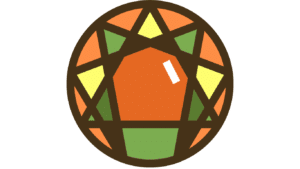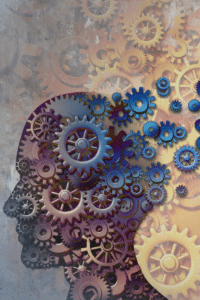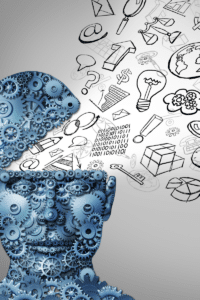Watch the Youtube Video!: What exactly is Enneagram?
What Exactly is Enneagram’s in 6 Steps?
First of all, the noun “Enneagram” is a combination of either the Greek words for “nine” (Ennea) plus “gramma” (things drawn or written).

Enneagram
Table of Contents
What Can We Learn from the Enneagram?
The Enneagram categorizes people into nine distinct types, each of which is distinguished by a distinct set of assumptions about the nature of reality. This central idea is the source of your deepest motivations and concerns. It shapes your worldview, your point of view, and the way you see the world and the people in it.
Though not always wrong, the convictions we hold most dear might act as “blinders” that prevent us from seeing the world around us objectively.
Recognizing our Enneagram personality type and how it influences our outlook on the world might help us see things more clearly and respond more appropriately.
If we can identify a person’s Enneagram type, we can better understand their motivations and actions. Every person in the Enneagram has a distinct personality and set of values that drive their daily behavior and inform their choices.
Understanding a person’s Enneagram type might help shed light on their seemingly irrational or incongruous actions.
The Enneagram can also shed light on how a person handles pressure. The Enneagram reveals avenues for growth and gives a foundation for comprehending others by outlining how each Enneastyle adapts and responds to both challenging and supportive conditions.

What exactly is enneagram?
The Meaning of the Enneagram Symbol
The nine-pointed geometric figure at the heart of the Enneagram provides the basis for its interpretation. The nine “points” (personalities) are uniformly placed and ordered clockwise around the outer circle.
In addition to the standard hexagon connecting the other points, there is a triangle formed by numbers 9, 3, and 6. The other shapes show how broken up human life is, while the circle shows how whole and connected it is.
What we call “wings” are the types that flank each “core” type. It’s thought that wings stand for several sides of our personalities that we might cultivate through metamorphosis.
Understanding the impact of the Enneagram wings can help one gain a deeper understanding of themselves, as many people strongly identify with the characterization of one or both of their wings in addition to their major type.
There are eight distinct personality types in the Enneagram, and each of these is connected to two others by lines. The first line relates to the person’s repressed or abandoned identity from their formative years; maturation necessitates reclaiming and integrating these traits.
The second line is a possible growth path in the future, which shows a possible personality type.
Each fundamental kind is connected to a set of strengths and challenges by these arrows. By adding these lines, the Enneagram goes from being a static model of personality to a dynamic one that shows how a person’s personality changes in response to new experiences.

The Meaning of the Enneagram Symbol
Functioning of the Enneagram:
Throughout a person’s development into maturity, one of the nine Enneagram personality types will emerge as the dominant influence on that person’s motivations and anxieties.
While your fundamental type is mostly determined by your genes, it is also affected by the dynamics of your family and your relationship with your parents.
Each type on the enneagram is represented by a number. Because it is a horizontal system of development, there is no “best” number. While some adults may identify with more than one type, it is generally agreed that people do not transition between the nine Enneagram personality types.
Instead, they reflect a variety of characteristics that are contextualized by how healthy they are.
There are nine distinct personality types, each with its own unique set of driving forces and phobias. Learn more about the nine distinct Enneagram personality profiles.
Origins of the Enneagram:

Origins of the Enneagram
The Enneagram has a complex and varied history, but its precise beginnings remain a mystery. Others argue that it arose from classical Greek philosophy around 2,500 years ago, while others place the origins in ancient Babylon around 4,500 years ago.
The Jewish Kabbalah, Christian mysticism, and the Islamic mystical tradition known as Sufism have all been credited with inspiring the design.
As a matter of fact, it has been suggested that Dante had a deep understanding of the Enneagram, as the personalities of the characters in The Divine Comedy closely mirror the nine different Enneagram types.
The modern Enneagram system, as far as we can tell, is the creation of modern authors. Mystic and spiritual teacher Georg Ivanovich Gurdjieff began using the model as a metaphysical symbol in the 1930s, and by the 1960s, it had made its way to the coasts of the United States.
Oscar Ichazo and Claudio Naranjo are two other well-known Enneagram instructors from the twentieth century. The Chilean psychiatrist Francisco J. Naranjo, who first encountered the Enneagram through Ichazo’s writings, is often credited with bringing the Enneagram into the mainstream of contemporary psychology.
Several spiritual and religious groups in the United States adopted the method after its initial rollout.
Modern studies of the Enneagram tend to focus on its psychological rather than its religious roots. Similarities to other personality models, like the Myers-Briggs, have been found.

Uses for the Enneagram
Uses for the Enneagram
The Enneagram is primarily used for introspective purposes, as it provides a potent instrument for gaining insight into one’s own personality and the motivations driving one’s actions. This can then be used to improve skills like communication, working in a team, being a leader, and being in touch with your emotions.
It is used a lot in counseling, psychotherapy, business growth, parenting, and education because it helps people understand their own strengths and areas where they can improve.
But even in a world of spies, knowledge of the enneagram may save an undercover agent’s life because it’s great help in controlling the unknown parts of the ego. That is why most secret agencies use the enneagram as an important part of spy education.
Multiple Enneagram personality tests and publications on topics as diverse as self-improvement, spirituality, interpersonal dynamics, and professional success have been derived from this theory, and they really work! .
Conclusion:
Despite the Enneagram’s apparent simplicity, it has far more nuance than meets the eye.
It’s not just another personality trait to criticize others or use to justify your own actions.
It can simply tell you:
Who You Really Are
The first step in the Enneagram is to determine “who” you are. The majority of personality profiling systems can be compared to this. According to the enneagram, your personality falls into one of nine categories.
The Essence of Who You Are (As Enneagram Defines)
The Enneagram goes farther by explaining “why” you are the way you are. Your intrinsic drive is the explanation for why you do what you do, think what you think, and feel what you feel.
How to Alter Your Behavior
However, the Enneagram doesn’t stop there. It equips you with the resources you require to learn “how” to alter your habits. The beauty of the Enneagram is that it reveals to you the path to your own greatest fulfillment.
Watch the Youtube Video!: What exactly is Enneagram?
Read more on personality types: https://psytify.com/personality-types/
For more information: https://en.wikipedia.org/wiki/Enneagram_of_Personality

2 comments
[…] continuing to question and seek answers, we can deepen our understanding of the world and make new discoveries that can benefit […]
[…] MBTI and the Enneagram’s descriptions of personality types are somewhat consistent with the Big Five. Though the level of […]